|
|
Melbourne

|
|
 |
|
|
Melbourne was a good race horse who might have been great had he been entirely sound during his career on the turf. He got seven classic winners, including the first English Triple Crown winner, West Australian, whose son, Australian, took the Godolphin Arabian sire line to America, where it flourished; another West Australian son, Solon, continued the line in England and Ireland through his son, the undefeated Barcaldine. Melbourne's daughters were excellent producers --as well as runners -- and had an impact on the breed world-wide. In addition to being a direct sire line descendant of the Godolphin Arabian, Melbourne carried more lines of that sire in his pedigree than any other stallion of his day: that foundation stallion appears thirty-nine times in Melbourne's pedigree.
Melbourne was the first foal of his dam, a bay mare by Cervantes, whose immediate female family line had been pretty much undistinguished for four or five generations. She was bred by Mr. Horsely of Low Catton, near York, from a Golumpus mare in 1825; Horsley had also bred her dam, and her granddam. Cervantes was bred by William Wentworth Fitzwilliam, Earl Fitzwilliam, in 1806 from Evelina, who was also the dam of the good race horse and sire Orville. Cervantes was sired by Eclipse son, Don Quixote (1784), who won some races, mostly matches at Newmarket over four miles, during his six years on the turf, to 1792. Cervantes' best foal had been Neva, a filly of 1814, who won the Oaks and the 2,000 Guineas; his daughters were good producers, and one of them produced a close relative of Melbourne's, the Comus son Grey Momus, who won the 2,000 Guineas.
Melbourne's dam was owned by George Robinson, a gentleman farmer at Carnaby, near Bridlington, in east Yorkshire, who had purchased her for £10. It was there she dropped her first foal, Melbourne, a plain brown colt with big ears and a narrow white stripe down the center of his face, in 1834. None of her subsequent foals made much of a mark on the turf, but Melbourne's sister, Minx (1835), became the dam of Royal Hunt Cup winner Sir Charles, and of The Grand Inquisitor, who won the Ebor Handicap, and of the Stockwell filly, Village Maid, who was tail-female ancestress of a number of good stakes winners in various parts of the world. A half-sister of Melbourne's, Minerva (1842, by Muley Moloch) was tail-female ancestress of the half-siblings Eremon (1900), who won the Aintree Grand National Steeplechase, and the filly Christmas Daisy (1905), who won the Cambridgeshire Stakes handicap twice. Another Melbourne half-sister, Maria (1839) was tail-female ancestress of 1869 Belmont Stakes winner Fenian, and of the good 1961 colt Hill Rise.
Robinson took his Cervantes mare and two others to the Comus son, Humphrey Clinker, the year the stallion arrived back in Malton from stud duty at the Fitzwilliam estates in Ireland. Humphrey Clinker was also bred by Lord Fitzwilliam, at his Wentworth Lodge stud in Yorkshire in 1822. After his turf career, he had stood briefly at William Allen's establishment at Malton in Yorkshire, and then was sent to Ireland for several years. When he was brought back to England, Fitzwilliam gave him to Allen, and the stallion spent his last two years once again at Malton. He was a fairly modest race horse of "immense size and power," who won six races during his career. Humphrey Clinker was a roarer, which may have affected his ability on the turf, a tendency toward which he probably passed on to his son, Melbourne, who was born the year he died.
Melbourne was an unprepossessing youngster, over at the knee, with a plain roman-nosed head, short neck, and very long from shoulder to hip. The Druid later wrote "...if you go into a paddock and see a lengthy plain-headed foal with lop ears gazing at you, it may be safely set down as a Melbourne," and his long back, plain head and large ears can be seen in the portraits of many of his offspring and grandchildren.
Eventually Melbourne reached 16 hands, with powerful shoulders and strong quarters, and despite the knees, had excellent bone and feet, which he often passed on to his youngsters. Unlike his sire, whose temperament, inherited from Comus, was not the best, Melbourne had a gentle demeanour. In the charming Herring portrait of Melbourne (above) he is shown communing with a young black and white cat while enjoying a rubdown by his groom.
While Robinson's other Humphrey Clinker colts sold as yearlings, Melbourne's knees forestalled a potential purchaser, and Robinson gave him to his son, Henry, to bring along. Melbourne was schooled without benefit of professional trainer in fields near Carnaby, and later at Hambleton. When in put training with Bob Hessltine, he fractured or damaged a bone in one of his forefeet, which exascerbated the difficulty of his training, and plagued him periodically throughout his career. He did not start in his first race until the age of three, and then he ran only once. He was described as "long-winded" when running, but William I'Anson, who had bred two fillies by him --the great Blink Bonny and her sister Blooming Heather -- noted that by 1855 (almost the end of his stud career) Melbourne had become a roarer. He had contracted "the distemper" in 1843, which was severe enough to cause his mares to be covered by Lanercost, and some turf writers feel its long-terms effects may have triggered an inherent tendency to roaring, inherited from Humphrey Clinker.
Melbourne on the Turf
At age 3, in 1837, he started once for the Gold Cup Stakes at Beverley, in which he ran second to Righton. At age 4, he won three races -- a £170 prize at York beating three fillies, including Miss Eliza, a daughter of Humphrey Clinker; a 25 sovereign compromise in a race at the same meeting; the three-mile Lincoln Cup, beating Miss Eliza and one other horse. He ran second to Percy in the Victoria Handicap at Doncaster. He failed to place in the more prestigious Liverpool Cup, and ran fourth and last in the Doncaster Cup won by Don John.
In 1839, his best year, he won six races: the 1 1/2 mile Cup Stakes at Beverley, beating five, and, at the same meeting, a £50 purse, beating three other horses; the Members' Plate at York, beating three horses; the 2 mile Liverpool Palatine Handicap Stakes, worth £450, beating Lanercost, Medea and several others, and also at Liverpool a £75 purse, beating the three-year-old filly Velocity; and finally the Cup at Nottingham, which was run twice because the horses were started from the wrong place--Melbourne won both times, beating Oaks winner Industry, Epirus, and other good horses who were withdrawn after the false run and did not race in its second installment. In two races that year he ran second--he was beaten by Beeswing at York in a run for the Queen's Plate, and he also ran second in a Queen's Plate at Nottingham, won by Tubal Cain. He failed to place in one race that year.
The following year, 1840, he ran once, possibly his greatest race, carrying 9st 4lbs, in the Cup at Chester, and placed second to the lightly-weighted Dey of Algiers (7 st-10 lbs), beating seventeen other horses, including Lanercost and Cruiskeen (who had won the Cesarewitch the previous year). His leg had given way prior to this race, and he had been very "delicately" and "skilfully" prepped for it with no gallops at all, but with a great deal of walking and sweating, and arrived at the post "so fit that the neighboring trainers, who had made great fun of this amateur training, were not a little surprised and disappointed." He could not catch the Dey, running on a "dreadfully hard" course, but ran "a singularly game horse, being beaten by little more than a head, though dead lame at the time." At the end of the race he could "hardly walk off the course." In all he had won nine of his seventeen starts, and placed second five times.
Melbourne at Stud
Melbourne began his career at stud near Carnaby, at first serving only Robinson's mares, and then standing at various sites around Yorkshire, such as the Rose and Crown in Beverley, at a fee of 10 guineas. He was then leased to George Kirkby and stood for three seasons at the Turf Tavern in York, at a fee of 10 guineas for thoroughbred mares, and 4 guineas for half-breds. From 1846 through 1850 Melbourne stood at Bonehill Farm, Fazeley, near Tamworth, Staffordshire, and during this period Robinson leased him to Lord George Bentinck, a confederate of the Bonehill Paddocks owner, Edward Peel; his stud fee rose to 15 guineas by 1847 -- by that time Sir Tatton Sykes had made his dual classic runs.
After, in 1851 and probably through 1853, he stood at John Scott's Cawston Lodge, near Rugby, at a fee of 18 guineas and under the care of William Scott, a well-known stud groom. According to later public correspondence regarding his stud career, he was mis-managed while at Bonehill, and when Scott -- who later managed West Australian and Stockwell for Lord Londesborough -- took charge of him, he ended the practice of only taking Melbourne out of his stall to breed mares, and began to take the horse on long three and four hour walks to exercise him. He spent a couple of years at Cawston Lodge, and then a year, 1854, at the Turf Tavern in Doncaster at a fee of 40 guineas, apparently managed by Scott for Robinson. He went back to Cawston Lodge in 1855, where the stallions Windhound and Birdcatcher were also standing -- and his fee was up to 50 guineas -- by then, of course, many of his good youngsters had made their mark on the turf. He was also, by then, 22 years old, and his fertility, periodically erratic throughout his career, had begun to decline; the stud book records eight 1856 foals, but he is listed as sole sire for only one filly, the other seven "by Melbourne or Windhound." The following year there were three, only one of whom had Melbourne listed as sole sire. In 1858, no foals were listed in the General Stud Book by Melbourne, and the following year he died.
In 1853 and 1857 Melbourne was the leading sire in England, and in 1854, second to Orlando. In 1855 he was fourth in the list to Touchstone, Orlando and Birdcatcher, and third to Birdcatcher and Orlando in 1856. His offspring won 424 races in England, and a total of 112,734 pounds.
Generally speaking his daughters were better than his sons, with the exceptions of one good colt, Sir Tatton Sykes, and one outstanding colt, West Australian, who won the English Triple Crown and other important races, and who carried on the Godolphin Arabian sire line. He sired five classic-winning daughters, including the great race mare Blink Bonny. His daughters were good producers, and Melbourne's name is present in the pedigree of many famous winners today because of them. As far as aptitude, Melbourne got many horses with both speed and staying and weight-carrying ability, and a number of durable runners that were successful over many seasons on the turf.
|
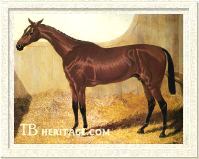
Sir Tatton Sykes | |
SIR TATTON SYKES was born in 1843 from a mare by Margrave. Jockey William Scott, who was an alcoholic, purchased him for £100 as a yearling from William Hudson, who had bought his dam, in foal to Melbourne, from J. Stables, a farmer near Brigham in Yorkshire. When Scott bought him, he named the colt Tibthorpe, after the village where a friend of his was born. After his 2,000 Guineas win, Scott renamed him in honor of Sir Tatton Sykes, the Yorkshire sportsman and owner of Sledmere, who had periodically employed Scott, one of the most successful of the great Yorkshire jockeys who was then nearing the end of his career. |
Scott rode SIR TATTON to victory in the 2,000 Guineas of 1846, after which, according to a possibly apocryphal story, he dismounted, got down on his knees, and thanked God "for having sent me a hell of a horse." [an alternative version has Scott, impressed with the colt's first gallops before the Guineas, thanking "God Almighty, that he has sent me a bloody clinker at last."] But Scott was so drunk during the running of the Derby, that Sir Tatton Sykes, well in the lead 2 furlongs from home, veered across the course due to lack of any guidance by his near insensate owner-rider, and lost the race by a neck to Pyrrhus the First. Scott and his horse won the St. Leger, a self-deputed guard of Yorkshiremen following Scott everywhere to keep him away from drink. Sir Tatton Sykes, the man, one who was determined to see his namesake win the St. Leger, afterwards kept a promise he made to Scott that if he won, he would act as groom to the horse to lead him in to the unsaddling enclosure following the race. This event was commemorated several times over in paintings and subsequent prints, by Harry Hall. SIR TATTON SYKES also won the Knavesmire Stakes at York that year, but lost the Grand Duke Michael Stakes to Iago, whom he had easily defeated in the St. Leger. At age four, after being beaten in Newmarket's Port Stakes, Scott sold Sir Tatton to a Captain Kennedy, who ran him three more times that year, winning once, a 500 sovereign match against The Traverser. At age 5, he ran twice without success. In all, he won four races and £5,855.
In the stud, SIR TATTON SYKES got French Oaks winner Ronzi, from the Rothschild's mare, Miami, and 1855 Cesarewitch winner Mr. Sykes (1850, from a half-bred mare). Another daughter, Verbena, became the founder of a top jumping family in Ireland. He died fairly early, in 1860, age 17. But for the inebriation of his jockey owner in the Derby, he almost certainly would have been England's first Triple Crown winner; as it turned out, that accomplishment was left to another Melbourne son, WEST AUSTRALIAN, seven years later. Even without the Derby win, SIR TATTON'S stellar performances as a racehorse led to increased patronage of Melbourne by a better class of mares. |
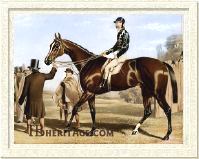
West Australian
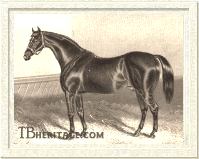
Prime Minister
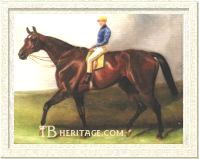
Melford
| |
WEST AUSTRALIAN, born in 1850, was out of the Touchstone mare Mowerina. He was bred by John Bowes of Streatlam Castle, County Durham, for whom he won the 2,000 Guineas, the Derby and the St. Leger at age three, becoming the first English Triple Crown winner. He was sold to the newly enriched and titled Lord Londesborough in 1855, and at age four won the Ascot Gold Cup and two other good races, after which he was retired to the Londesborough stud at Kirkby Farm, Grimston Park, near Tadcaster in Yorkshire. In all, WEST AUSTRALIAN, Melbourne's best runner, won ten races and £14,135.
He got Australian (1858), who later became an influential sire in the U.S., tail-male progenitor of Fair Play, and Solon (1861), who continued the Godolphin Arabian sire line in Ireland. WEST AUSTRALIAN was purchased by the Duc de Morney and sent to France in 1860, where he got a French Oaks winner, and Ruy Blas, a good racehorse and sire of classic winners.
PRIME MINISTER was, according to the turf commentator The Druid, a "flyer," being a Melbourne foal who was "rather short," those being the ones, he said, who "hit best for speed." He had the typical Melbourne long back. He won eight races, his best being the 5 furlong-142 yard Clearwell Stakes at age 2, and the Port Stakes at age 4, both at Newmarket. He placed second four times, in handicaps at York twice, Northampton and Worcester -- at Worcester he was beaten in the County Stakes handicap by another Melbourne son, the gelding MELFORD, and ran third in the Ascot Queen's Vase and a Newmarket handicap sweepstakes at age 3. He won a total of eight races. He was born in 1848, out of Pantalonade, a Pantaloon daughter, and was bred and raced by his owner, a Mr. Halford.
MELFORD ran for seven years, between 1847 and 1853, winning four races, including the Worcestershire Stakes in 1852, and stakes at Croxton Park, Reading and the handicap noted above at Worcester.
|
Other Melbourne sons who had some success on the turf were: OULSTON (1852), won the Wilton Park Stakes at Salisbury at age 2 and the Ascot Queen's Vase at age 3, beating Rataplan and Saucebox, the latter subsequently winner of the Doncaster St. Leger, and a total of 7 races. CANNOBIE (1853) ran third to Ellington in the Epsom Derby and later won the Great Metropolitan Stakes, one of his two career wins. TOWTON (1850), a useful juvenile runner that won one race and placed several times, was purchased after retirement by Thomas Newton and imported into New Zealand, where, at Christchurch, he got a number of good runners that took the New Zealand Cup, Wellington Cup and other distance races, and broodmare daughters, including important Colonial family mares, that bred on.
In the stud, a Melbourne son, BROCKET (1852), who had won three races in his career, got Cambridgeshire winner Margery Daw who became the dam of See Saw, a sire of good stayers. Other colts who won a number of races included MENTMORE (11), WESTLOW (14), and THE ASSAYER (18).
Another Melbourne son, THE PEER (1855, brother to Oaks winner MARCHIONESS), was sent to Australia, where he became a good sire. His son, Darebin, who resembled Melbourne --"rugged" and "unrefined" were adjectives applied to him -- was a great stayer and weight-carrier, who won the V.R.C. Derby, the Melbourne Stakes, the Royal Park Stakes, the Sydney Stakes, the A.R.C. St. Leger and the Birthday Cup. Darebin was purchased by American James Ben Ali Haggin and sent to Haggin's vast Rancho del Paso stud in California, where he ended up siring primarily sprinters, rather than stayers. Among his get was Emma C., a big and not particularly pretty filly, purchased by James Keene at Haggin's annual yearling auctions on the east coast of the U.S., who was one of the few Darebins who could win up to four miles. She became the dam of Commando.
YOUNG MELBOURNE, bred by Lord Glasgow in 1855 from Pantaloon mare Clarissa started just once, at age 2, when he was beaten in a match by Whitewall, but he fell in the race, and that was the end of his career on the turf. However, he became a decent sire. Among his get was GENERAL PEEL, who won the 2,000 Guineas and the Doncaster Cup, and was second in both the Derby and the St. Leger. Young Melbourne's son, THE EARL, owned by (Lord) Arthur Hastings, was favored for the Derby when scratched, creating a Jockey Club uproar; he was likewise scratched for the St. Leger, but he won the Grand Prix de Paris and the St. James Palace Stakes, among other races. In all, Young Melbourne got over 25 winners.
Young Melbourne's daughters had some influence on the breed. A daughter, Mint Sauce, was the dam of Grand Prix de Paris winner Minting (1883). Minting's daughter, Maid of the Mint, was the dam of Spearmint. Son Rapid Rhone was a winner, and sire of 1873 Grand National steeplechase winner, Torrent, and of Bonnie Doon, the latter from Queen Mary, whose daughters Wharferdale, Bella-Donna and Bonnie Gal, had an important impact on thoroughbred stock in the U.S. Young Alice was the dam of Irish Derby winner Ben Battle (sire of top handicapper Bendigo and a leading sire in Ireland of flat racers and jumpers), and another Young Melbourne daughter, Wheat Ear, was second dam of Grand National steeplechase winner The Soarer. An unnamed daughter of Young Melbourne produced the great broodmare, Quiver, the dam of the triple classic winning mare and good producer, La Fleche, and through daughter Maid Marian, second dam of Polymelus, five times leading sire in Great Britain.
Melbourne's Daughters
Melbourne had two stellar daughters -- CANEZOU, a great staying mare who started her career by winning the 1,000 Guineas, and BLINK BONNY, the second horse to her time to ever win both the Derby and the Oaks. Both, as it turned out, were also excellent producers. Other classic winning daughters by Melbourne included CYMBA, who won the Oaks, MENTMORE LASS, who won the 1,000 Guineas, and MARCHIONESS, another Oaks winner. Other daughters were also good race horses, among them BLOOMING HEATHER, who came in second in the Oaks, and TASMANIA, who won the Yorkshire Oaks.
A number of Melbourne's early daughters, from the 1840s, bred mostly obscure horses for several generations, but the lines were valued enough to continue; many of their female line descendants ended up in other countries, particularly in central Europe, where their progeny became top stakes winners. Among the early Melbourne fillies was an unnamed daughter of 1844 from the Phantom mare, Lisbeth. Her great-granddaughter in tail-female was Stewards Cup winner Marigold, who produced the Derby winner, Doncaster, sire of Bend Or.
John Huby, who served as the stud manager at Sir Tatton Sykes' Sledmere stud and at the Duke of Portland's Welbeck stud for many years in the latter quarter of the 19th century, said of Melbourne mares: "For size and width of frame I have never seen anything to equal them in the thoroughbred line. Two of the biggest mares I ever saw were by him. They were Countess of Westmoreland and Stolen Moments, but I could name several other daughters of his that approached these two very closely in size. Nearly every one was more or less -- generally more--affected in the wind; but when mated with horses of quality -- such as Newminster, for instance -- they proved excellent broodmares, and I used to notice they bred their stock with more quality than they themselves possessed."
|
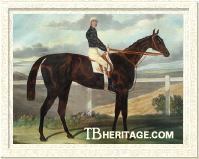
Canezou
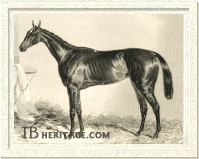
Cymba
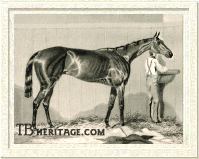
Marchioness
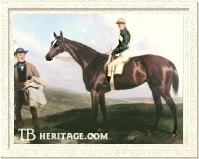
Blink Bonny
| |
CANEZOU, born in 1845 from Madame Pelerine (Family 31), a Velocipede mare, was one of Melbourne's best racing daughters. In addition to her descent from Sorcerer via Melbourne, she also had two lines to Sorcerer through her dam. She was also one of the best horses owned by Edward G.G. Smith-Stanley, then Lord Stanley and later the fourteenth Earl of Derby and thrice England's Prime Minister. Trained by John Scott, with whom she was a favorite, she debuted at the age of three in the 1,000 Guineas, which she won. She later won the Nassau Stakes at York, the Ebor St. Leger, beating Flatcatcher, and the Park Hill Stakes, and was beaten by a neck into second place by Surplice in the Doncaster St. Leger. A great, game, staying mare, she won the Goodwood Cup at age 4, and repeated that win at age 5, also winning the Doncaster Cup that year.
CANEZOU also did well in the stud, producing Paletot, a winner of the St. James Palace Stakes, to Touchstone, and Fazzoletto (1853), by Orlando, who won the Great Yorkshire Stakes and the 2,000 Guineas. Her daughters were excellent producers: La Bossue (by DeClare), was the dam of the great Vermout son, Boiard (1870), who won the Ascot Gold Cup and, among other races in France, the Prix du Jockey Club (French Derby), the Prix Royal Oak (French St. Leger) and the Grand Prix de Paris. Another daughter, Basquine (1859, by Orlando) was the tail-female ancestress of a host of classic winners in South America, South Africa, Italy, France, Hungary, Germany and Australia, in addition to a number of stakes winners in the U.K.
CYMBA, also a foal of 1845, was, unlike, CANEZOU, unlucky in her owner, Harry Hill, who made his living betting and had questionable associates in John Gully and others associated with turf scandals. Out of Skiff (Family 2 - m), a Sheet Anchor mare, she debuted in the Oaks, which she won, beating some smart fillies. The next year she ran in the Grand Stand Plate at Epsom, in the Royal Hunt Cup at Ascot, and in a Handicap plate at Newmarket, and was unplaced in all. None of her immediate offspring were particularly successful, but later descendants in tail-female included the good runner Stedfast (1908, Coronation Cup, Jockey Club Stakes and others), the Grand Prix de Paris winner Popof (1951), and Doncaster Cup winner Pinfold (1895).
|
MENTMORE LASS was the 1850 daughter of Emerald, one of Baron Mayer de Rothschild's foundation mares at Mentmore, and his first classic winner, winning her debut in the 1,000 Guineas by two lengths. Her dam also produced a fairly good runner in King of Diamonds (1852, by King Tom), who won Doncaster's Champagne Stakes. Mentmore Lass did not train on well. After retirement, she produced a number of foals for the Baron, but her best by far was a daughter of her old age, Hannah (1868), by King Tom, who won three classics -- the 1,000 Guineas, the Oaks and the St. Leger. The good stayer Radium (1903), winner of the Doncaster Cup, the Goodwood Cup and the Jockey Club Cup twice, was a tail-female descendant of MENTMORE LASS.
MARCHIONESS (1852), another northern filly, bred by Samuel Hawke and sold to Rudston Read of Doncaster, was out of the Touchstone mare Cinizelli, who also produced the dual-classic winning colt The Marquis (by Stockwell), and a brother to MARCHIONESS and TOWTON. She ran once, at age 2, coming in second in a sweepstakes for two year olds at Doncaster, beating a fair field. Her first start at age 3 was the Oaks, which she won, beating another Melbourne daughter, BLOOMING HEATHER (out of Queen Mary) by half a length. She was entered in the St. Leger, but failed to place. The following year, she ran four times in good races, but placed only once, a second in a handicap at Lincoln. After a poor showing in her first race in 1857, she was retired to the stud. She was eventually sold to Australia, in foal to Stockwell, where she produced two good sons in The Angler (Victoria Derby, Victoria St. Leger), and Fishook (AJC St. Leger, Sydney Cup, Victoria St. Leger), both by Fisherman, and a daughter that bred on there.
BLINK BONNY, another Yorkshire-bred heroine and Melbourne's best daughter, was foaled in 1854, bred, trained and raced by Malton-based William I'Anson, who owned her dam, Queen Mary (Family 10 - a). She was a very good two-year-old, winning eight of her eleven starts, including the Gimcrack Stakes. At age 3 she won both the Derby and the Oaks, and it was generally believed she would have won the St. Leger, had her jockey, John Charlton, not been paid to hold her back. She won the Park Hill Stakes, two days after the St. Leger, with ease and in faster time than the St. Leger winning time posted by Imperieuse. In all, she won 14 of her 20 races to the age of four. BLINK BONNY had just three foals, dying young: her daughter, Borealis, ran third in the 1863 Oaks. Her next, the flashy chestnut Blair Athol (1861, by Stockwell), won the English Triple Crown, and was four-times leading sire in Great Britain, sire of five classic winners. Her last youngster was Bredalbane (1862), brother to Blair Athol, who later got a number of influential youngsters, including The Ill-Used, who became a leading sire in the U.S.
BLOOMING HEATHER (1852) (Family 10 - e), who ran second to MARCHIONESS in the Oaks, was a full sister to BLINK BONNY, out of Queen Mary. Her daughters were prolific and successful in the stud, and she is accorded her own branch of Family 10 due to the numerous stakes winners the descend from them in tail-female, among them a number of German classic winners and quite a few good French fillies who won the French Oaks. Battleship, the Melbourne sire line Man o'War son who won the Grand National and American Grand National, also descends from Melbourne via BLOOMING HEATHER.
TASMANIA, an 1854 daughter from a mare by Picaroon (Family 2 - s), won Doncaster's Champagne Stakes and the Yorkshire Oaks, and ran second in the 1,000 Guineas and the Great Ebor Handicaps at both York and Doncaster. Her son, Leolinus (1871) won the St. James's Palace Stakes and the Prince of Wales's Stakes. She also established a very sound tail-female family full of classic winners: the great South American champion and sire, Botafogo, descends from her, as do the good sire Busted, 2,000 Guineas winner Clarrisimus, two-time Arc de Triomphe winner Alleged, and the great American Triple Crown winner, Secretariat.
VICTORIA (1853), a sister to WEST AUSTRALIAN, from Mowerina, won the Yorkshire Oaks, the Ascot Coronation Stakes, the Stockbridge Triennial Stakes and the Newmarket Royal Stakes, and ran third to Mincepie in the Oaks. She later produced War (1863), who won the Ascot Stakes, dam of The Spy, who won the Northumberland Plate and the Liverpool Cup. Another full sister of WEST AUSTRALIAN, GO-AHEAD (1855), won the Nassau Stakes, beating dual-classic winner Governess. Her grandaughter, Mowerina (1876, by Scottish Chief), produced Derby and St. Leger winner Donovan, Chester cup and Gold Vase winner Raeburn (1890, by St. Simon), later a leading sire in Austria, and Semolina (1887, by St. Simon), who won the 1,000 Guineas and was ancestress of Al Hattab and other good winners.
LADY ALICIA, an 1852 daughter of Melbourne, was a pretty good race filly, and at age 2 won the Champagne Stakes at Stockbridge and ran third in a sweepstakes at Winchester; she later produced the outstanding jumper sire, Ascetic, and was also third dam of Amphion, the latter a weight-carrying miler that later got the brilliant runner and English leading sire Sundridge.
Another Melbourne daughter, BLANCHE OF MIDDLEBIE (1855), a sister to RAMBLING KATE (1852, who later produced Chester Cup winner Paul Jones), out of Touchstone daughter Phrynne, won the Ham Stakes for two year olds, beating the later Derby winner, Beadsman, and ran third to Sunbeam in the St. Leger. Yet another Melbourne daughter, GADABOUT (1850), won the Great Metropolitan Stakes.
Among Melbourne's many successful producing daughters, the following are of special interest.
FIRST RATE, born in 1847 from the Bedlamite daughter, Ninny, produced Cambridgeshire winner Red Eagle (1856). SILENCE, an 1848 mare from Secret, a Hornsea daughter, was the second dam of Sterling, the sire of Isonomy.
CHARITY, an 1850 filly from Benevolence by Figaro, had a good daughter, Gratitude (1860), by Newminster, that won the Royal Hunt Cup. MABELLA (1850), from a Perion mare, Charlotte, was sent to Germany, where she produced German Derby winner Seemann (1869). Another 1850 daughter, THE BLOOMER, from Lady Sarah (Family 13 - b) a Velocipede mare, produced Ascot Gold Cup and Goodwood Cup winner Ely, and two of her daughters, established strong families which include Irish Derby winner Rock Star; a number of Chilean classic winners; the 1934 mare Morning Dew, who produced four Irish classic winners; and Epsom Derby winner George Frederick.
VIOLET (1851) from Snowdrop by Dr. Syntax had several good daughters that bred on, including Virgule (1865, by Saunterer), who won the Furstenberg Rennet, and in turn produce three top horses -- Vinaigrette (1873), winner of the Gran Prix de Deauville, and Vizir (1878), winner of the Prix Jean Prat, and Grand Criterium winner Vigilant (1879), the latter two both by Vermout. Another 1851 daughter, SORTIE, from the Touchstone daughter Escalde, produced two good youngsters -- Out and Outer (1862) and Repulse (1863), who won the 1,000 Guineas -- and was the dam of Citadel, who got the champion older horse and four time leading sire in the U.S., Glenelg..
THE SLAVE (1852), from Volley by Voltaire (Family 2 - h), produced two good winners: Lady Clifden, who won the Stewards Cup; and Lord Clifden, who won the St. Leger and six other good races, and sired, among others, Hampton (1872), an outstanding stayer who also won over obstacles, and who was leading sire in England in 1887. Another filly of 1852, LADY PALMERSTON, from a Pantaloon mare, had a stakes winner in her Orlando son, Temple, and was third dam of the great Australian racehorse and sire Grand Flaneur; Kentucky Derby winner Double Jay also descends from LADY PALMERSTON. RAMBLING KATIE, also 1852, from the Touchstone mare, Phyrne, was dam of Chester Cup winner Paul Jones and of Bill of Fare, from who descend in tail-female Gunner B and the good 20th century race horse and sire, Theatrical.
The filly crop of 1853 included TAPESTRY, from Hornsea's daughter, Stitch. She produced the great French racing filly La Toucques (1860, by The Baron), who won the French Oaks, French Derby and French St. Leger, and the German race, Grosser Preis von Baden. THE MERMAID (1853), from Seaweed, by Slane, established a strong female family in central Europe, with top winners in Austria, Hungary, and Poland. She was grandam of the great racemare Kincsem, and other descendants included the racehorse and sire Wagram. SECRET (1853), from Merlin daughter Problem, was third dam in tail-female of Pilgrimage (1875), who won both the 1,000 and 2,000 Guineas and was dam of the influential mare, Canterbury Pilgrim.
|
 | |
Melbourne's Influence on Jumpers
For years horsemen valued Melbourne's blood in hunters and steeplechasers, prized for stamina and courage. He himself got the 1857 Grand National winner EMIGRANT (1846), from Pandora, a half-bred mare by Derby winner Cadland. His sire line, extending well into the 20th century, produced some of the best 'chasers ever bred in England, Ireland, Europe and America, from Man o' War's son, little Battleship (1929), to the great Easter Hero and other sons of My Prince. His daughters, and his sons' daughters also established jumping lines.
|
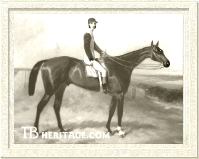
Emigrant
|
Melbourne's daughter, LADY ALICIA (1852 from Testy by Venison, Family 12 - c), from whom Marcovil, Amphion and Broker's Tip descend in tail-female, produced the great 'chaser sire Ascetic, who led the jumping sires lists between 1887 and 1904. He got, in addition to three Grand National Winners, the horse Royal Meath, who won the Conyngham Cup and the Grand Steeple-chase de Paris and was later a good jumper sire. Ascetic's daughter Rosegraft produced the 1923 Grand National winner, Sergeant Murphy (1910, by General Symons), and another daughter, Diane produced Troytown (1913, by Zria), the 1920 Aintree champion.
|
| This chart excludes winners descending from Melbourne's sons, West Australian and Sir Tatton Sykes; refer to the Godolphin Arabian sire line chart to view Grand National winners and other top steeplechasers who descended from those tail-male lines. This chart has been reformatted from a chart provided by Andreas Haberbeck. |
Another Melbourne daughter, the "big and roomy" STOLEN MOMENTS (1852, from Lady Elizabeth by Sleight of Hand, Family 8 - j), from whom a number of good flat runners descend, including a number of South American champions, produced Great Yorkshire Stakes winner Castlereagh, who sired 1894 Grand National winner Why Not, and many other winning chasers and hurdlers.
Two more Grand National winners, Roquefort, who won in 1885, and Scottish-bred Old Joe, the winner in 1886, descend via Lord Clifden who was from Melbourne's daughter, THE SLAVE. Old Joe had a double-dose of Melbourne through his sire, Barefoot, whose dam, Stockings, was out of a Melbourne daughter, the aforementioned GO-AHEAD. Another son of Lord Clifden, dual-classic winner Petrarch (1873), got another leading sire of steeplechasers in England -- first or second in the lists for twelve years -- Hackler, whose dam, Cambridgeshire winner Hackness, traced back to another Melbourne daughter, THE BLOOMER. Hackler sired two Grand National winners -- Jenkinstown (1901) and Covertcoat (1906) -- and dual Irish Grand National winner Little Hack II, whose dam was a mare by Ascetic.
Two daughters of YOUNG MELBOURNE were second dams of Grand National Winners: Young Alice was the dam of Ben Battle, who became a good jumper sire, and got Ambush II, the Prince of Wales' Aintree winner in 1900; Wheat Ear (1867, from Swallow by Cotherstone), produced Derby winner The Harvester, Coronation Stakes winner Redwing, and Ascot Gold Vase winner Skylark, who sired the 1896 Grand National winner The Soarer and other good jumpers. Steelpoint, a leading sire of jumpers in the late 1940s and early '50s, was by Spearmint, who had two lines of Melbourne through his dam, Maid of the Mint, and one through his sire Carbine, who was out of a mare by West Australian. Steelpoint's dam, Laragh, also had several lines of Melbourne through her sire and dam.
Melbourne's son, SIR TATTON SYKES, sired Verbena (1854), who was sent to Ireland, where she founded a great female line of jumpers. Her daughter, Sweetbriar (1870) produced Eglantine, who won the Irish Grand National in 1887 and later was dam of 1898 Grand National winner, Drogheda. Sweetbriar also produced Sweetberry, dam of Irish Grand National winner Thurles, who later sired Eremon, the Aintree winner in 1907. Another daughter, Bayberry, was second dam of Irish Grand National winner Pay Only. Other good jumpers also descended from Verbena.
Some lines from WEST AUSTRALIAN also produced good jumpers. His son, Solon (1861), sired Irish Grand National winner Controller (1873) and Grand Steeple-Chase de Paris winner Whisper Low (1878). Solon's grandson in tail-male, Marcovil, got the top chaser sire My Prince (1911), who had also had lines to Melbourne via his dam. My Prince got three Grand National Winners, the great Easter Hero, and another top jumper, Prince Regent; the latter had ten lines of Melbourne in his pedigree. Another WEST AUSTRALIAN son, Ruy Blas (1864), had two close-in descendants in France that won the Grand Steeple-Chase de Paris.
At much further remove, tail-male descendants of Melbourne continued to be and sire good jumpers: Man o' War sired Maryland Hunt Cup winner Blockade and Grand National and American Grand National winner Battleship, who in turn got two winners of the American Grand National. Werwolf (1919), a son of Hurry On, got Grand National winner Bogskar (1933) and Cheltenham Gold Cup winner Silver Fame (1939), in addition to a number of other good jumpers. Another son of Hurry On, Precipitation (1933), sired Furioso (1939), who is still influential in many top international show jumper pedigrees.
|
 | |
Melbourne lived to the age of 25. When at Cawston Lodge Stud, he had fallen off a mare, Escalade (the dam of his 1851 daughter, Sortie), "...and it was all they could do, after several weeks of care, to coax him the three miles to the station. When we saw him in September he was wasted to a shadow, his gaunt dusty neck seemed a rood long, and he had a painful stringhalt to boot..." His death was scheduled for February of 1859, but "he rallied, and got a reprieve till May 4." Melbourne was shot on May 5, 1859. His head was preserved and mounted in Henry Robinson's house. In a garden near the entrance to the village of Carnaby, Robinson erected a small memorial column in honour of Melbourne.
--Patricia Erigero |
|
|
|

